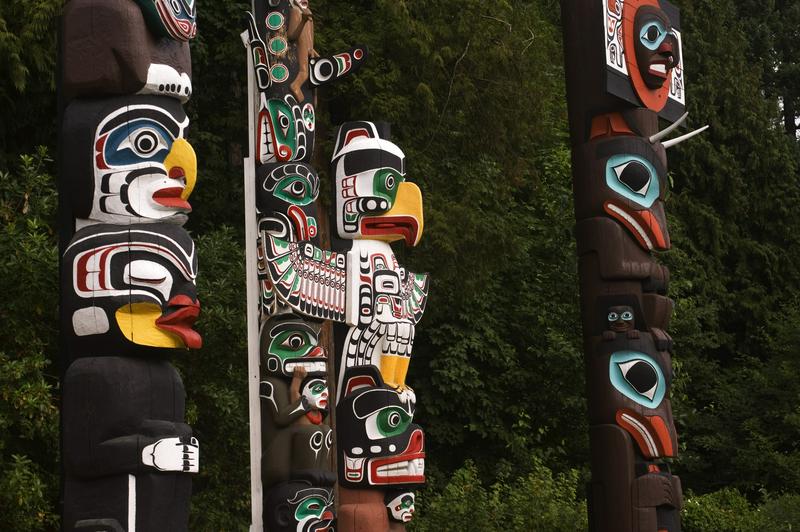What Are Totem Poles?
By | September 17, 2019

Everybody thinks they know what a totem pole is, but in actuality, few fully understand its origin, symbolism, social importance, and how it still represents the old conflict of colonizers versus indigenous people.

A Symbol of Prestige and Heritage
Totem poles were and are created by Pacific Northwest Native Americans ranging from Vancouver Island to Alaska. These tribes include among others the Haida, Tlingits, Bella Coolas, and Kwakuitls. Totem poles are usually crafted of red cedar which was ubiquitous in the region. On the cedar, craftsmen carve images of animals, family crests, clan crests, or some combination. Each one of these figures can symbolize a particular clan’s power and lineage. Salmon, frogs, bears, eagles, orcas, and the mystical thunderbird are among the various motifs used to decorate a totem pole.

The Tallest Totem Pole
While most totem poles are from 10 to 50 feet high, some of the larger totem poles are upward of 65 feet high. The world’s tallest totem pole may be found on Cormorant Island in Alert Bay, British Columbia and is an incredible 173 feet high. However, it must be noted that there is an asterisk under this record since this totem pole was created with two pieces instead of the traditional one. Purists would say that the world’s tallest totem pole is a 140-foot single piece in Kalama, Washington.

The First Totem Poles
Nobody knows when the first totem poles were carved, but they were noted by Captain James Cook on his exploratory expedition in 1778. It is generally agreed the art form only developed within the last few centuries.

House Posts
There are a variety of different kinds of totem poles that serve either architectural or ceremonial purposes. Native longhouses often had “house posts” that helped support the building. Likewise, there are also “frontal long poles” which were at the front of the house containing an opening for entrance.

Mourning Posts
“Mortuary poles” or “mourning posts” served as a gravestone and memorial to a deceased person while “memorial poles” were erected to honor an important lost ancestor or a person of significance. One of the most interesting pole types is the “shame pole” which tribes would erect in order to embarrass a tribe that owed them a debt.

Shame Poles
Nowadays, tribes rarely construct shame or ridicule poles except as a form of protest against white incursions into native lands or some other political grievance. For example, Mike Webber, a Tlingit fisherman, built a shame pole in Cordova, Alaska in outrage over the Exxon Valdez oil spill in Prince William Sound. Another famous ridicule pole is the Seward Pole in Saxman, Alaska which depicts Secretary of State William H. Seward for not reciprocating after a potlatch feast was held in his honor.

Diversity
Totem poles also had incredible variation between the different tribes of the Pacific Northwest. Some, such as the Coastal Salish only erected house posts, while the Haida and the Tsimshian erected truly spectacular poles of over 100 feet. The best place to see the variety of totem poles is to visit Stanley Park in Vancouver, British Columbia. The nine totem poles at Brockton Point in the eastern corner of the park are British Columbia’s most popular tourist attraction and had been acquired for made for the park since 1986.

Ceremony
Much ceremony surrounds totem poles from tree selection to erection. Usually, for a significant raising of a totem pole, the people would hold a potlatch, a Native American feast where gifts were given out or even destroyed to symbolize a person or clans wealth. Even though red cedar is rot-resistant, a totem pole usually lasted about a century before finally disintegrating -- but even this was considered part of the life cycle of the pole.

Peak and Decline
The creation of totem poles peaked in the 19th century. This was in part due to contact and trade with Europeans who gave the tribes tools by which they could create more elaborate poles. But then after white incursions that compelled them to give up what was viewed as “pagan practices” including totem poles (seen as idolatry) and the culturally important potlatch. Starting in the 1920s, however, there has been a movement to preserve totem poles. From the 1950s onward, totem pole carving has seen a renaissance that continues to this day.

An Ongoing Battle
Also ongoing is the fight of Native Americans to get their totem poles back. Over the years, totem poles had been taken, often without permission, and given to museums or taken into private collections. Thus the subject of totem poles still remains a sore subject and an object of Native Peoples to assert their rights.

